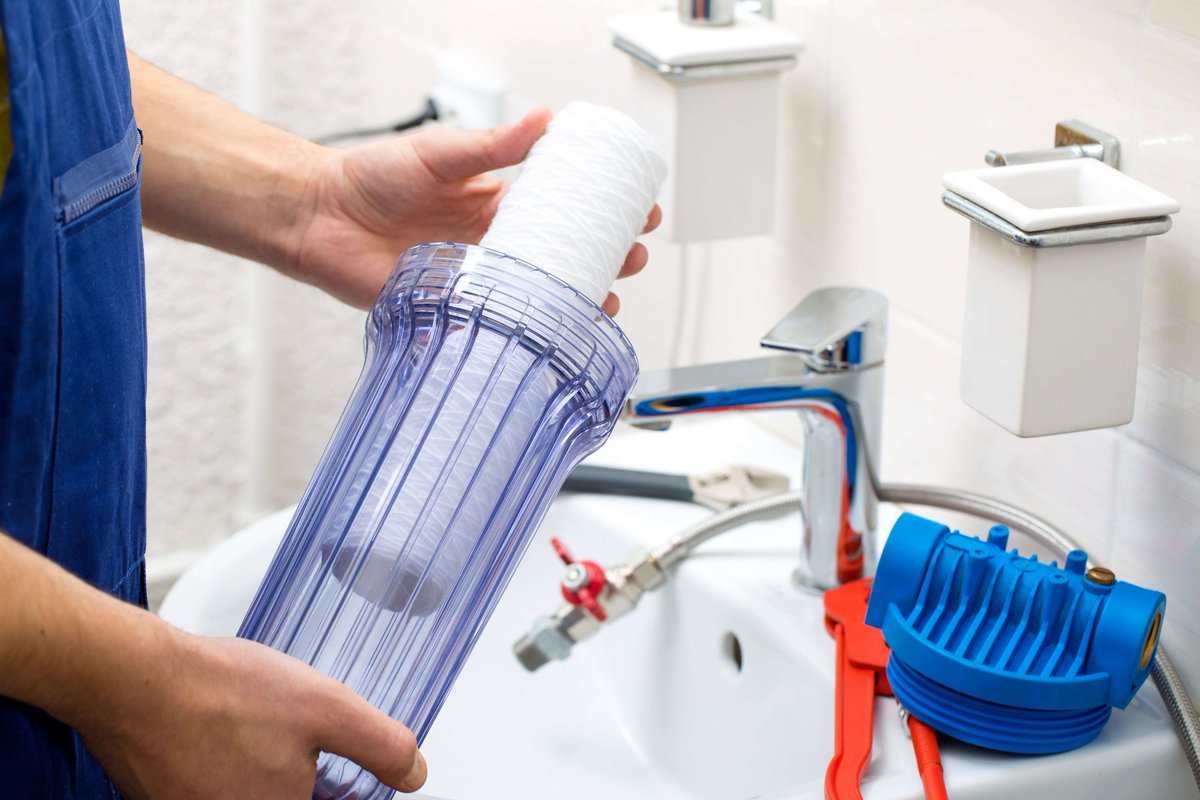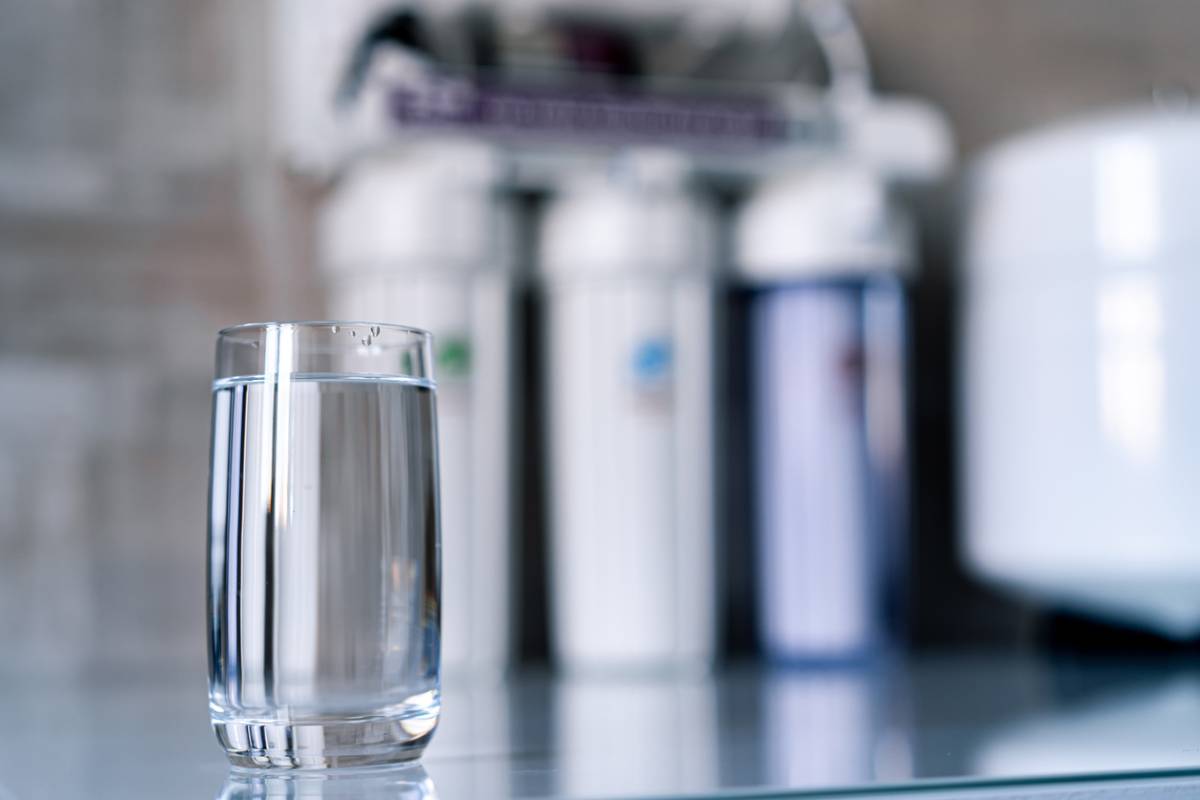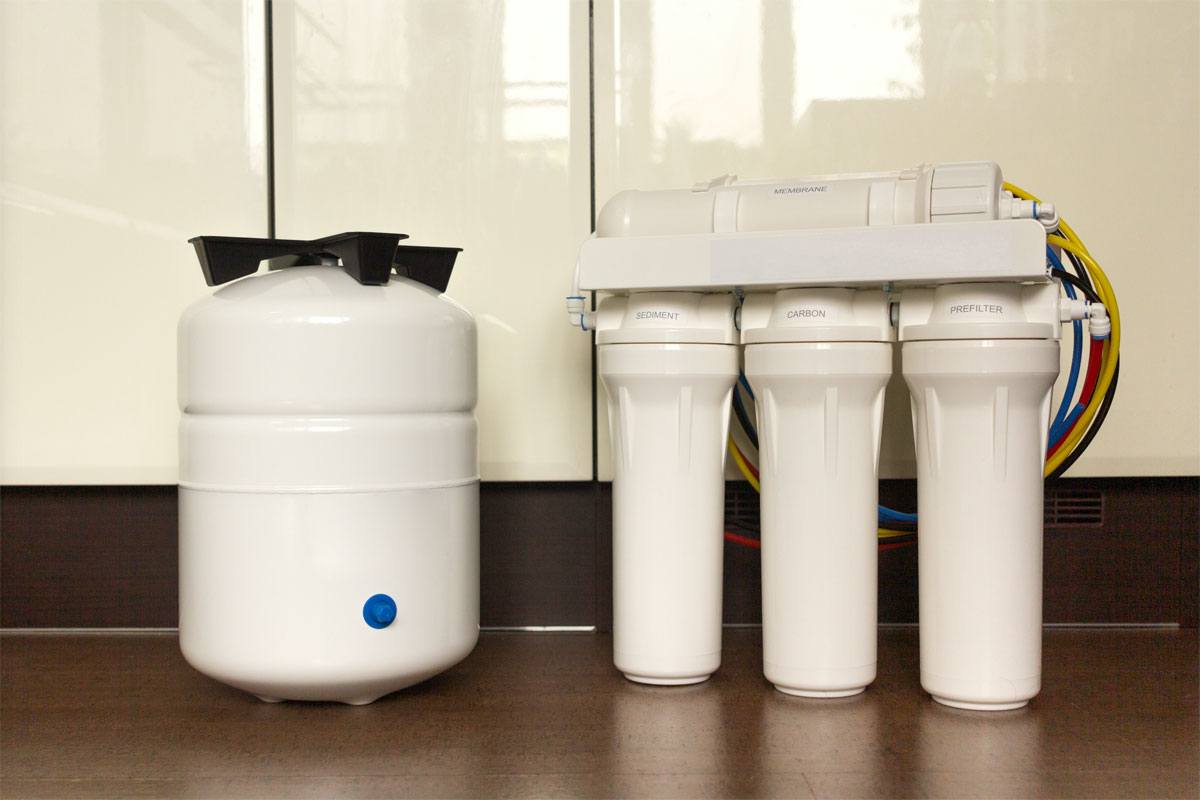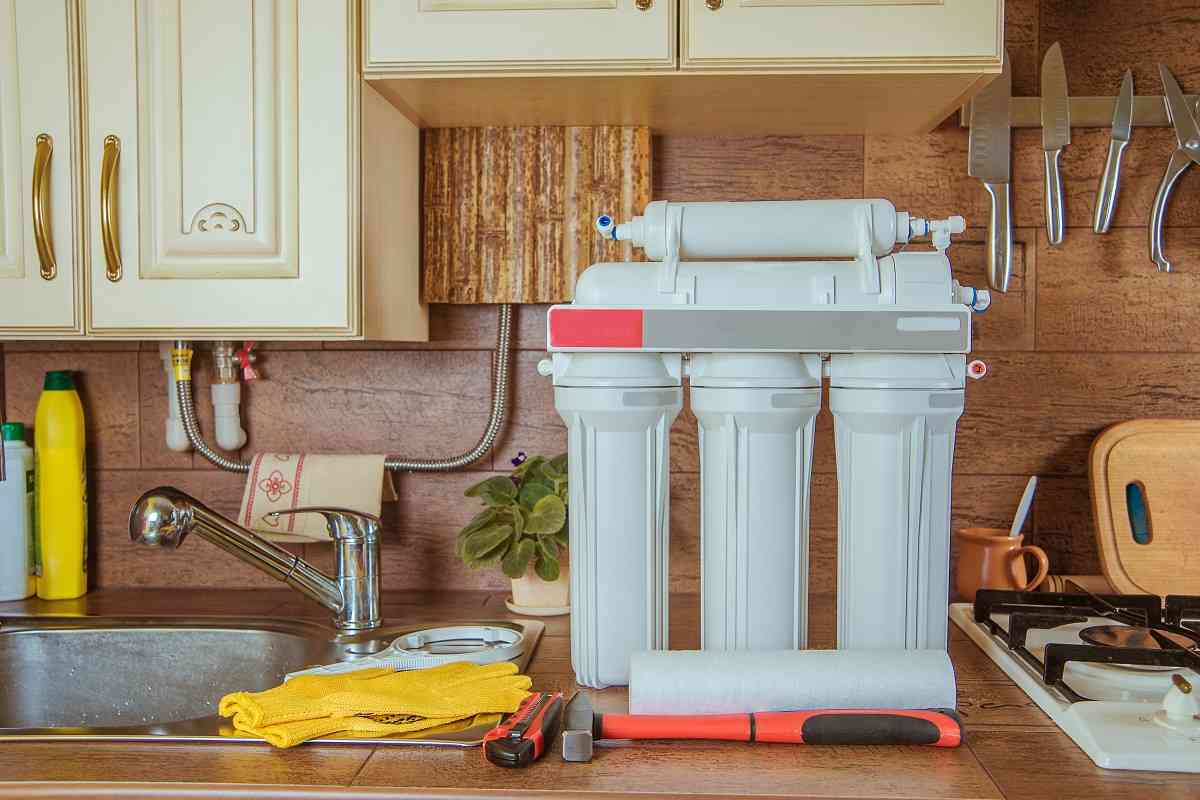water purifiers use different types of filters. Each kind of these filter has its materials and its efficacy as well. Water purification mostly depends on the number and material of the filters. In this article, we talk about the different materials which are used in the water purification process. Each of these materials is explained in detail based on their respective materials and specifications. After reading this article about the materials in water purifier filters, you can decide which kind of filter is suitable for your purpose.  TREATMENT, BUT NOT FILTRATION To disinfect your water supply, water utilities will either employ chloramines or chlorine. Maintaining residual chlorine or chloramines in the water after it leaves the treatment plant is a regulatory requirement to ensure that the water remains pathogen-free on its journey to your house. Large utilities will typically employ chloramines because it does not dissipate as quickly and produces fewer disinfection byproducts (such as THMs and chloroform). There are several methods for water filtering. UV filters, activated carbon, reverse osmosis, and mixed media are the most prevalent systems. Adding chlorine to treated water has saved many people from waterborne diseases over the years, but it is also one of the reasons why many people dislike the taste and smell of their tap water. As a powerful oxidant, chlorinated water can also have a drying impact on the skin and hair. The chlorine residual in the water system must be maintained; however, there are no health benefits to consuming it. To determine which filter media product is most efficient at removing chlorine, it is necessary to examine the water quality report provided by the water utility and to determine if the utility uses chlorine or chloramine. NOT EVERY FILTER IS EQUAL Understanding how your water is processed can help you determine which filtering medium to use. And believe us, there are a variety of water filtering methods. UV filters, activated carbon, reverse osmosis, and mixed media are the most prevalent systems. However, the majority of filtering systems employ a mixture of these techniques. Ultimately, the optimal system for a residence is determined by the water quality in that location. The water source (lake, river, etc.), the chemicals used at the water treatment plant, and further information about the city's water infrastructure have a significant impact on water quality.
TREATMENT, BUT NOT FILTRATION To disinfect your water supply, water utilities will either employ chloramines or chlorine. Maintaining residual chlorine or chloramines in the water after it leaves the treatment plant is a regulatory requirement to ensure that the water remains pathogen-free on its journey to your house. Large utilities will typically employ chloramines because it does not dissipate as quickly and produces fewer disinfection byproducts (such as THMs and chloroform). There are several methods for water filtering. UV filters, activated carbon, reverse osmosis, and mixed media are the most prevalent systems. Adding chlorine to treated water has saved many people from waterborne diseases over the years, but it is also one of the reasons why many people dislike the taste and smell of their tap water. As a powerful oxidant, chlorinated water can also have a drying impact on the skin and hair. The chlorine residual in the water system must be maintained; however, there are no health benefits to consuming it. To determine which filter media product is most efficient at removing chlorine, it is necessary to examine the water quality report provided by the water utility and to determine if the utility uses chlorine or chloramine. NOT EVERY FILTER IS EQUAL Understanding how your water is processed can help you determine which filtering medium to use. And believe us, there are a variety of water filtering methods. UV filters, activated carbon, reverse osmosis, and mixed media are the most prevalent systems. However, the majority of filtering systems employ a mixture of these techniques. Ultimately, the optimal system for a residence is determined by the water quality in that location. The water source (lake, river, etc.), the chemicals used at the water treatment plant, and further information about the city's water infrastructure have a significant impact on water quality.  Even the pipes in a home might contribute to contamination if they contain lead, copper, or other heavy metals that leach. To learn more about the water quality in a particular region, consult your city's Water Quality Report. The EWG also provides a simple zip code search tool on this page. In the majority of filtration systems, water travels through media. Filtration media are the workhorse of these systems, removing a variety of pollutants from the water. The type of pollutants removed by the filtering system is entirely determined by the medium. While some media remove a wide variety of pollutants, others concentrate on only a few. Below are seven common filtering media utilized in drinking water systems. The Use of Activated Carbon
Even the pipes in a home might contribute to contamination if they contain lead, copper, or other heavy metals that leach. To learn more about the water quality in a particular region, consult your city's Water Quality Report. The EWG also provides a simple zip code search tool on this page. In the majority of filtration systems, water travels through media. Filtration media are the workhorse of these systems, removing a variety of pollutants from the water. The type of pollutants removed by the filtering system is entirely determined by the medium. While some media remove a wide variety of pollutants, others concentrate on only a few. Below are seven common filtering media utilized in drinking water systems. The Use of Activated Carbon
- Carbon Activate
Activated carbon is the most popular medium by a wide margin. When organic material with a high carbon content (such as wood, coal, or coconut shells) is heated in a manner that prevents combustion, char is the outcome. The char is then processed to generate a porous substance that binds to certain poisons and pollutants, removing them from the system's circulating water. Again, it is essential to understand that not all activated carbon is manufactured from the same basic material. Activated carbon may be produced from coal or coconut shells, the latter of which has a far less environmental effect. Almost every water pitcher filter, water bottle filter, and the majority of whole-house water filtration systems use activated carbon.  It eliminates organic pollutants, byproducts of chlorination, lead, copper, and some pesticides. Additionally, it reduces the chlorine taste and odor left by the water treatment plant. Catalytic Carbon
It eliminates organic pollutants, byproducts of chlorination, lead, copper, and some pesticides. Additionally, it reduces the chlorine taste and odor left by the water treatment plant. Catalytic Carbon
- Catalytic Carbon
Catalytic carbon is an upgraded kind of activated carbon with enhanced catalytic properties. It is primarily used to remove chloramine, a chemical that is increasingly employed to disinfect water at water treatment plants. Chloramine has gained popularity due to its ability to prevent the growth of germs when water travels through pipes. However, for the same reason, it is extremely difficult to remove chloramine from water once it reaches the tap, unlike chlorine. While activated carbon eliminates a tiny amount of chloramine from drinking water, catalytic carbon removes the vast majority. KDF Media
- KDF (Kinetic Degradation Fluxion)
This medium includes largely copper and zinc particles and is used to remove water-soluble heavy metals such as chlorine, iron, and hydrogen sulfide. In addition, it regulates the water's scale, germs, and algae. It is quite efficient in removing chlorine, although it is not as effective at removing chloramine as carbon/GAC.  In opposition, this medium is less expensive to run, lasts longer, and performs better at higher temperatures than carbon, performing well in warmer water. Utilizing KDF material upstream of a carbon filter is highly effective. The KDF prolongs the life of the carbon, and the carbon is effective in reducing the levels of chloramine and THM.
In opposition, this medium is less expensive to run, lasts longer, and performs better at higher temperatures than carbon, performing well in warmer water. Utilizing KDF material upstream of a carbon filter is highly effective. The KDF prolongs the life of the carbon, and the carbon is effective in reducing the levels of chloramine and THM.
- Multimedia
This is a catch-all phrase. As its name indicates, mixed media is a combination of multiple mediums used to remove additional pollutants and poisons. These media may comprise gravel for filtering silt from water, resin for filtering tannins from water, or catalytic carbon for reducing chloramine concentrations.
- Reverse Osmosis Membrane
Reverse osmosis is a widely used water filtering method that eliminates a substantial percentage of pollutants from water, including hazardous substances such as asbestos and hexavalent chromium. It functions by forcing water across a semipermeable membrane that enables water molecules to pass through but captures water-soluble toxins such as heavy metals, organic compounds, microorganisms, and pyrogens.
- Ultraviolet light (UV Filtration)
The water is pushed into a room containing ultraviolet light. The UV photons generated are adjusted to a frequency that is most effective against microorganisms. These rays penetrate the cell walls, destroying contaminants' DNA and preventing their reproduction. This renders harmful pollutants harmless, such as E. coli and giardia.  UV filtering is implemented at all stages of water treatment. Not only is it a proven method for removing harmful germs and viruses, but it does it without contaminating the water with harsh chemicals.
UV filtering is implemented at all stages of water treatment. Not only is it a proven method for removing harmful germs and viruses, but it does it without contaminating the water with harsh chemicals.
- Activated Aluminum
Activated aluminum is typically found in ion exchange units, where it eliminates magnesium and calcium, two minerals responsible for "hard water." This sort of media may also remove fluoride and arsenic from water given sufficient contact time. Depending on the type of activated aluminum, radium and barium can be filtered out. Aluminum activation is also known as a resin.
- Manganese Dioxide
There are a few forms of media in which manganese dioxide is the major component. In water, these media decrease iron, manganese, and hydrogen sulfide. Although iron is essential for human health, it functions as a secondary pollutant in water, causing issues when brewing tea or coffee or cooking vegetables. Excess iron in drinking water can stain dinnerware and clothing with a reddish-brown hue.
